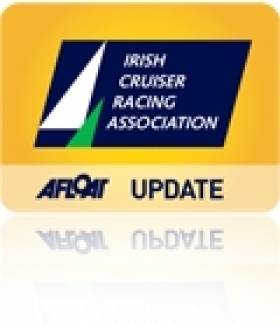Displaying items by tag: ISORA
iPhones At The Ready as Offshore Yacht Racing Goes Digital
#iphone – Navigating with the iphone is on the cards for Saturday's first ISORA race of the season with courseoptions for crews on both sides of the Irish Sea. Dublin offshore sailors will race from Dun Laoghaire to North Arklow buoy and back while Welsh counterparts are to race a similar distance along the Welsh coast.
In deploying the new mobile technology ISORA has teamed up with 'Predict Wind Tracker' to track the boats in both races. This, says ISORA, is a cost effective method of recording the race that can be viewed live and also viewed after the event.
This feature can only work at present on the iPhone and Android.
Depending on the wind direction ISORA may include "waypoint marks" as part of the course. ISORA Commodore Peter Ryan has issued a reminder to the offshore fleet emphasising it is essential that crews are familiar with how the phones are used and what and when you must record the rounding.
Ryan adds that if the innovative approach to setting courses is successful, 'it will radically change offshore racing to the betterment of all'.
#isora – As the leading Irish offshore series gets ready for a coastal race in a fortnights time, ISORA series sponsor, Kona, marked its third year of sponsorship with a new trophy presentation for the Dun Laoghaire to Pwllheli ISORA Race. This race will be the seventh race in the 2014 ISORA series and is scheduled for Saturday 26th July. The race is also the feeder race to the IRC Welsh Championships in Pwllheli in North Wales.
Michael Martyn KONA's Chief Executive Officer said that he was delighted with the great relationship that has been established with ISORA on the Irish Sea.
£8m National Sailing Centre Underway in Pwllheli, North Wales
#ISORA – The main contractor for the new £8.3m National Sailing Academy and Event Centre has been appointed in Pwllheli, North Wales. The substantial dredging works has already started and the new dedicated visitor and event pontoons will be completed by June and be available for the IRC Welsh Championships in August just after the Dun Laoghaire to Pwllheli ISORA feeder race.
The organisers, including ISORA Champion, Stephen Tudor, is keen to attract as many boats across the Irish Sea as possible.
The IRC National Championship is an open event and will use the facilities of the Welsh National Sailing Academy and Event Centre and will draw on the skill and experience of the Academy's event team who regularly run World and European Championships.
This work says Tudor will enhance and extend the events capacity in Pwllheli and will improve access to the world renowned sailing waters of Cardigan Bay with the provision of new dedicated visitor and events berths with cranes located adjacent to the marina.
ISORA to Track Races with Wind Tracker iPhone App
#ISORA – Offshore sailors are preparing for the 2014 season with the first ISORA race now only five weeks away. The first race is a coastal day race in Ireland - the Dun Laoghaire - North Arklow buoy – Dun Laoghaire coastal race. At the same time there is also a day bay race from Pwllheli in North Wales. It is hoped, says Commodore Peter Ryan of the National Yacht Club in Dun Laoghaire, that this 'easy race' will coax a big turnout and particularly those boats starting to train for June's Round Ireland race.
The first offshore race is the Holyhead to Dun Laoghaire Race on Saturday 10th May. Download the full 2014 ISORA Calendar of races here.
This season 'waypoint' marks will be used to ensure that full beats and runs will be provided in races. At least one crew member requires an iPhone and to have downloaded the Predict Wind Tracker app. Every race will be set up on the Predict Wind website and will be live on the website and replayable afterwards. This will be a particularly useful tool in monitoring boats rounding the new 'waypoint' marks.
The main offshore event this season is the Offshore Racing Weekend in June that starts with the Midnight Race from Liverpool to the Isle of Man on a Friday night and finishes with a return race from the Isle of Man to Dun Laoghaire, starting on the Sunday morning. The race is a feeder for the ICRA Nationals in Dun Laoghaire.
New ISORA Team Series for 2014 Offshore Sailing Season
#ISORA – All boats entering the ISORA series in 2014 will have the option of taking part in a Team Series, Saturday's AGM at the National Yacht Club in Dun Laoghaire was told.
The teams of 3 will be randomly selected by the committee and each team will consist of a boat from Class1, 2 and Silver Class. It is hoped that this will encourage boats to take part in more races. There will be a trophy for the Team Series.
The AGM also head that ISORA is to clarify the qualifying conditions for boats entering the Wicklow SC's Round Ireland with the race organisers. This could alter the length of some of the races prior to the Round Ireland.
There will be an ISORA coastal series that will consist of results from the coastal / day races only. It is hoped that this will encourage those boats who do not do the cross channel races. There will be trophies for this series as well.
Virtual marks will be used in races to ensure, weather permitting, that there is an upwind and a dead downwind leg in each race.
The mandatory use of the PredictWind tracker was discussed. While there was unanimous agreement that the use of such a tracker was of huge benefit to ISORA, there were some technical difficulties experienced with its use last season. ISORA is to engage with PredictWind to sort these issues
out prior to next season.
The prize giving dinner took place in the National Yacht Club on Saturday evening. The dining room was packed with 165 people. The pre-dinner reception took place in the JB room. The classical trio "The Trident Trio" provided the background music while the guests mingled and chatted.
ISORA commodore Peter Ryan acted as MC for the prizegiving. Traditional toasts were made by Mr James Cannon, Director of KONA, Mr. Paul Barrington, Commodore NYC, Mr. Barry MacNeaney, Commodore Royal Alfred Yacht Club and Mr. Derek mathews, Commodore of the Royal Dee Yacht Club. Anne-Marie Ryan presented the many prizes to the winners. The prizes included unique personalised "KONA" jackets for race winners and Series Class Winners.
ISORA 2014 Offshore Programme Includes New Welsh IRC Nationals & IOM Midnight Race
#isora – 2014's proposed ISORA offshore racing programme on the Irish Sea (scroll down this page to download the proposed programme) has some innovative new races attached including a new isle of man fixture plus a brand new Welsh IRC championships.
The draft season programme promoted by ISORA commodore Peter Ryan includes the prospect of a great offshore weekend in early June with a 'Midnight Race' from Liverpool to Douglas IOM on a Friday afternoon with a race from Douglas to Dun Laoghaire on the Sunday morning. This weekend also feeds to the ICRA Nationals hosted by the Royal Irish YC in Dun Laoghaire.
Two months later there is also a new event in Pwllheli/Abersoch on the 1st-3rd August the Welsh IRC Nationals. Ryan has proposed a new feeder race for the event from Ireland and the Royal Dee YC have presented a trophy – "The Tidal Cup" for this race as well as the usual ISORA trophy.
ISORA's Conwy race will act a qualifier for any boats doing the Round Ireland as it will be 100 miles and the hope is that as many ISORA boats will enter.
Views on the programme will be aired this Saturday at ISORA's agm at the National Yacht club where the association dinner is already booked out.
ISORA Attracts More Harbours for 2014 Irish Offshore Sailing Circuit
#isora – The 2014 Round Ireland race brings more interest to a burgeoning Irish Sea offshore scene (ISORA) next June and while ISORA commodore Peter Ryan of the National Yacht Club (NYC) is not proposing to include this 704–mile offshore race in the ISORA schedule there are plans afoot to widen ISORA's traditional reach and move some races at least away from the traditional Dun Laoghaire – Pwllheli race axis.
Conwy in North Wales are keen to host a race start on the 10th May for the up to 30–boat fleet and the response to the Isle of Man (IOM) race last year was huge.
The first May Bank Holiday is the annual Round the IOM race completed during an extended weekend and there is a suggestion this could be accommodated within the trip to and from the Island.
On the Irish east coast Arklow is also a keen location and the new marina at Greystones is also a new venue. In Dublin Bay there are four weekends of regatta races scheduled in 2014. Skerries in North Dublin have expressed an interest and regular ISORA venues at Dun Laoghaire, Howth and Wicklow are all still keen to maintain links across the Irish Sea as are the Welsh ports of Holyhead, Pwllheli and Abersoch. An IRC event is being hosted in August for Abersoch and Pwllheli.
Discussions on featuring the new ports will be a main part of ISORA's agm this month with suggestions already being made that Carlingford in County Lough or Ardglass, Co. Down, situated just south of Strangford, and other Northern Irish Sea ports be considered too.
The annual ISORA AGM will be held in the NYC at 15.00 on Saturday 16th November, same day as the dinner.
ISORA Champions 'Sgrech' Retain Title in Final Race to Dun Laoghaire
#isora – Under not ideal weather and sea conditions yesterday's final ISORA race of 2013 was a battle of gargantuan proportions between the Series leader "Ruth" and close second "Sgrech". The two J109's, with "Sgrech" only giving 43 seconds in the expected 12 hour race "Ruth" writes ISORA chairman, Peter Ryan.
After a long season with many boats having races and sailed thousands of miles. With some boats with gear problems and others with crew fatigue after three consecutive weekends of offshore racing, only 13 boats out of an entry list of 22 came to the start line in Pwllheli. The PSC starter Richard Tudor sent the fleet of on a direct course from the start to the finish in Dun Laoghaire.
The weather forecast appeared to be very manageable with the winds of maximum 25 knots, north west backing south west over the day. Unfortunately the north west wind had been blowing strong for all the previous day producing overall conditions at Bardsey that were not pleasant. The first leg to Tudwals was a tight reach. After the warning signal "Sgrech" and "Ruth" commenced manouvers to get the better start. The two boats headed off in front of the fleet within a boat length of each other towards Tusdal's sound.
In Tudwal's sound more tussles arose between the tow boats in the form of a luffing match. This facilitate "Pipedreamer 6", "Mojito" and "Lula Belle" to pass them into the lead. Sea condition past Tudwal's sound warned of what was going to be met at Bardsey. It was a beat to Bardsey. While most of the fleet chose to go through the sound with the north going tide some boats including "Sarnia" ventured outside the island. The five lead boats arrived at Bardsey close together with "Ruth" and "Sgrech" exchanging tacks.
Conditions at Bardsey Sound were "pretty bad"!!!!. Huge and breaking seas met those who ventured through. "Sgrech" recorded a ground speed of 14.2k at one stage. "Windshift" suffered some slight gear damage with the pounding and retired. At the same time the life raft on "Sgrech" broke its fixings and was heading off the stern before the crew managed to retrieve it. "Poppy of Brighton" had retired earlier.
Exiting Bardsey "Ruth" and "Sgrech" were still within boats lengths of each other and leading the fleet with "Mojito" close behind and headed off north on a beat in the north going tide. The wind was still north west. Over the following few hours, the backing wind lifted the boats on the north leg of the beat to arrive north of the Bailey lighthouse. At all time "Ruth" and "Sgrech" were within 100m of each other with the boast being side by side "Ruth" being to weather. Felloe J109 "Mojito" was close behind.
It was only just approaching the Kish Light that "Sgrech" regained the advantage and set the scene of the tacking duel between the two boats across Dublin Bay to the finish at Dun Laoghaire Pier heads. "Sgrech" held the lead and finished just 1 minute 50 seconds ahead of "Ruth". "Mojito" finished approximately 10 minutes behind the leaders to give the J109's a 1st, 2nd and 3rd place overall and Class 1. "Sarnia", the oldest and lowest rated boat in the fleet took Class 2 and Silver Class Overall with "Lula Belle" taking 2nd Class 2 and "Yahtzee" taking 3rd Class 2 and 2nd Silver Class while Sigma 33 "Polished Manx" took 3rd Silver Class.
The result of the gargantuan battle between "Ruth" and "Sgrech" was that "Sgrech" retained the ISORA lynx metmAsts Offshore Series 2013 champion status, ahead of "Ruth". "Polished Manx" is the ISORA lynx metmAsts Offshore Silver Series 2013 champion. Full details are below.
The usual "dignified" end of series party took place in the NYC immediately after the race.
The progress of the race was recorded using the PredictWind tracker but some boats had technical problems. It can be viewed on the iPhone or smartphone app or on the website at http://forecast.predictwind.com/tracking/race/ISORA It is hoped to make the use of this tracker as mandatory for next years races however this will be discussed at the ISORA AGM in the NYC on the 16th November.
The prize giving will take place at the ISORA annual dinner to be held in the NYC on the 16th November. To avoid disappointment, it is vital that places are booked early with the club.
It was a fitting and exciting end to a very success offshore series where, with the possible exception of yesterday's race, all the races were sailed in great racing conditions. It is hoped that this close racing will attract new boats to enter and race "outside of the Bay".
ISORA Race Win for J/109 Jedi
#isora – Race 10, the last Dun Laoghaire ISORA Day Race and run in conjunction with the Royal Alfred Yacht Club, took place on Saturday 31st August writes Peter Ryan. The course was to be to the M2 weather buoy and back but the weather forecast of very light winds forces the Sailing Committee to review this. The forecast was for 10-15 knots Northwest decreasing 5-10 and backing to West. It was agreed that the course would be shorter and would send the fleet south on the tide to Moulditch and East Codling returning to Mugllins. After Muglins there was an option that the fleet could ten head out to South Burford and back to Muglins before finishing.
The weather forecast was somewhat correct but that did not appear to be the case as RAYC Commodore, Barry MacNeaney, sent the fleet of 17 boats speeding out of Dublin Bay under spinnaker in 20 knots of breeze with the first boats arriving at Moulditch after just over a hour!!! It was looking like an early shower for everyone. "Tsunami" was first around with "Jedi", "Lula Bella" and "Adelie" close behind. Then the weather forecast took its toll as the first boats approached East Codling – the wind dropped. Just as all the boats rounded in the buoy in the last of the south going tide, the wind disappeared altogether.
As the fleet wallowed in the lop, "Jedi" managed to make some short progress north in the now north going tide. After an hour, wind appeared to be filling slowly in from both the north west and the south!!. "Jedi" caught the first of the north west wind and accelerated off towards the Muglins while the remainder of the fleet fumbled around, some setting spinnaker for the fickle south wind. "Jedi" was a distant dot when the north west wind finally got to all the fleet. The wind appeared to settle at a pleasant 10 knots until the well bunched fleet were off Bray Head. All of a sudden the 10 knot wind became 20-25 knots and boats were sent scrambling to reduce sail. This wind held for the remainder of the race.
Nothing would have caught "Jedi" at that stage as it approached the finish line. Then a potential disaster for "Jedi" was averted when their forestay broke and the rig was only supported by the jib halyard tension. Quick thinking and the rapid use of the spinnaker halyards prevented the rig from collapsing. With this jury rig, "Jedi" limped across the finish line to take line honours, Class 1 and the overall race. Next to cross the line, 31 minutes behind was "Tsunami" who only managed a 2nd in Class 1. The remainder of the fleet was well bunched and the last boat crossed the finish just one hour 50 minutes after "Jedi".
The bunching of the fleet at East Codling allowed the lower rated boats to take command. ISORA newcomers "Rupert" and "Sunburn" took 2nd and 3rd place overall and 1st and 2nd in Class 2. A Sigma race within a race was organised with "Rupert" taking 1st, "Pippa 4" and "Elandra" taking to other places.
The finishers were Kathryn Meagan and Michael Horgan from the NYC.
The race was recorded using the PredictWind Tracker app for iPhones and other smart phones. Unfortunately only 6 boats activated this essentially free facility. The track for the race can be viewed on the app and also in the website at http://forecast.predictwind.com/tracking/race/ISORA . This is a great facility and allows those not privileged to take part in the ISORA race to follow it and those that did, to relive their mistakes!! I strongly urge, request and beseech all boats to avail of this great facility and activate it for the last race. The app is freely available "PredictWind
Tracker". As the race is a cross channel race, data roaming is required on the phone being used.
Following immediately after this race is the last race of the series next weekend from Pwllheli to Dun Laoghaire. This is a crucial race and the overall winner of the ISORA lynx metmAsts 2013 Offshore Series and the coveted "Wolf's Head" will be decided. It is hoped that the biggest fleet of the season will collect in Pwllheli for the popular race. The pre-race social in Pwllheli for this event is legendary!!!
A complimentary ISORA lynx metmAsts Crew Bus will be available to bring crew from Holyhead to Pwllheli. It will meet the 13.30 HSS and 14.30 Swift on Friday 6th September. Crew taking advantage of this concession must contact me ASAP.
ISORA Race Pwllheli Prize Won By National Yacht Club J109, Ruth
#isora – Of the 20 boats entered 13 came to the start line at 08.00 on Saturday 24th August to be set off for Pwllheli by Vice Commodore of the NYC, Larry Power writes Peter Ryan.
Some of the entrants had only recently completed the Fastnet Race and one, "Mojito", not only completed the Fastnet Race but also took part in Abersoch Week immediately prior to this race, arriving at the NYC pontoons at 06.00 for the 08.00 start!
As with this summer we were plagued with good weather but unfortunately little wind was forecast. The forecast was for north-west 15-18k, backing to south west 10-12k and decreasing, wind disappearing in the late afternoon before appearing again in the evening in the north- west. This is exactly what happened. The problem of the light winds was compounded by the exceptionally strong tides on the day and the fact that as the fleet started south the tide had just turned north!!
Because of the uncertainty of the wind and the certainty of the strong tides and particularly the problems it could cause at Bardsey, the Sailing Committee decided to set the course direct to the Finish at Pwllheli.
The fleet left Dublin Bay in the NW wind, most taking the west run tack while some sailed very deep and east. The seas were surprisingly choppy for such tame wind conditions. "Lula Belle" took that charge off the start line and led the fleet down the coast towards Wicklow. The strong wind against tide stirred up the seas producing some spectacular overfalls inshore of the
Codling Bank. Tide against the fleet of up to 4k were recorded. As has become normal in the ISORA races, the J Boats, "Ruth", "Sgrech" and "Mojito" took to the front with "Adelie" and "Lula Belle" close behind.
Most boats chose to gybe east just north of Wicklow. All of a sudden, out of the east appeared "Yahtzee"!!!!! who crossed in front of most of the fleet but continued her march south. There was good separation of boats along a north-south line heading towards Bardsey Island. It was essential to have passed through Bardsey Sound before 19.00 after which time the tidal gate would slam closed.
The impending light airs appeared to spook some of the fleet with "Satisfaction", "Sarnia" and "Windshift" retiring by late afternoon. "Obsession" only retired after banging on the closed tidal gate at Bardsey for several hours.
First to reach Bardsey Sound just after 18.30 was "Ruth" followed closely behind by "Mojito" and "Sgrech". Not far behind them was "Lulla Belle" and "Adelie". The first three boats managed to get through in slack tide that started to catch the following boats. What happened after this is not clear!!! "Ruth" who was a mere half mile ahead accelerated towards Pwllheli while the progress of all the other boats behind started to falter with the decreasing winds.
"Ruth" steamed across the finish line manned by ISORA Vice Chairman, Gerry Williams of Pwllheli Sailing Club just after 22.00 hours. "Sgrech" managed to haul itself over the finish at 24.00 while "Mojito" took another
frustrating hour to cross the finish. At this stage the usually timid tides in Tremadog Bay had been roused and was holding the remainder of the fleet at St Tudwal's. The fleet were not released until the tide and turned again and the remaining fleet started to limp over the finish line from 05.00 hours.
"Ruth" took line honours and winner overall and Class 1. Sigma 33 "Elandra" sailed a great race in difficult conditions to snap up Class 2 and Silver Class Overall. Full race results are attached. I also attach the Series results after 9 races.
The Overall Series is hotting up with "Ruth" out in front but not home safe yet!! There is much to play for in the last two races over the next two weekends. A large fleet is expected for the M2 Day Race and success in this could have a significant effect on overall placings despite the 0.9 points factor. The last race on the 7th September, the James Eadie Race from Pwllheli to Dun Laoghaire, is always well supported. It is hoped that the Overall series will not be decided until the results of the last race are known.
On the PredictWind Tracker issue we had limited success in its use in this race. It would appear that only three boats activated their trackers. Winner "Ruth" used the tracker very successfully and it is clearly displayed on the app or by following this link using Google Chrome or Firefox browser, NOT Internet Explorer:
http://forecast.predictwind.com/tracking/race/ISORA
I will investigate why other trackers did not appear either partially or fully. I would appreciate feedback on this as I see this as a great tool to analyse races afterwards. It is hoped that most boats taking part in the M2 day Race will use and activate the tracker.





























